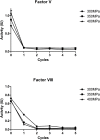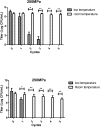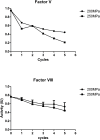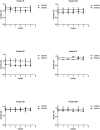Development of High Hydrostatic Pressure Applied in Pathogen Inactivation for Plasma
- PMID: 27561010
- PMCID: PMC4999174
- DOI: 10.1371/journal.pone.0161775
Development of High Hydrostatic Pressure Applied in Pathogen Inactivation for Plasma
Abstract
High hydrostatic pressure has been used to inactivate pathogens in foods for decades. There is a great potential to adapt this technology to inactivate pathogens in plasma and derivatives. To better evaluate the potential of this method, pathogen inoculated plasma samples were pressurized under different pressure application modes and temperatures. The inactivation efficacy of pathogens and activities of plasma proteins were monitored after treatment. The CFUs of E.coli was examined as the indicator of the inactivation efficiency. The factor V and VIII were chosen as the indicator of the plasma function. Preliminary experiments identified optimized treatment conditions: 200-250MPa, with 5×1 minute multi-pulsed high pressure at near 0°C (ice-water bath). Under this conditions, the inactivation efficacy of EMCV was >8.5log. The CFUs of E. coli were reduced by 7.5log, B. cereus were 8log. However, PPV and S. aureus cannot be inactivated efficiently. The activities of factor II, VII, IX, X, XI, XII, fibrinogen, IgG, IgM stayed over 95% compared to untreated. Factor V and VIII activity was maintained at 46-63% and 77-82%, respectively.
Conflict of interest statement
I have read the journal’s policy and the authors of this manuscript have the following competing interests: ZX is employed by Zhengzhou Feilong medic devices Co,. Ltd. This does not alter our adherence to PLOS ONE policies on sharing data and materials.
Figures







Similar articles
-
Inactivation of pathogens in single units of therapeutic fresh plasma by irradiation with ultraviolet light.Transfusion. 2009 Oct;49(10):2144-51. doi: 10.1111/j.1537-2995.2009.02234.x. Epub 2009 May 27. Transfusion. 2009. PMID: 19497052
-
Pressure cycling technology: a novel approach to virus inactivation in plasma.Transfusion. 2000 Feb;40(2):193-200. doi: 10.1046/j.1537-2995.2000.40020193.x. Transfusion. 2000. PMID: 10686003
-
High hydrostatic pressure treatment for the inactivation of Staphylococcus aureus in human blood plasma.N Biotechnol. 2012 Feb 15;29(3):409-14. doi: 10.1016/j.nbt.2011.10.003. Epub 2011 Oct 11. N Biotechnol. 2012. PMID: 22008386
-
The development of high hydrostatic pressure processes as an alternative to other pathogen reduction methods.J Appl Microbiol. 2011 Jun;110(6):1359-69. doi: 10.1111/j.1365-2672.2011.05000.x. Epub 2011 Mar 30. J Appl Microbiol. 2011. PMID: 21395952 Review.
-
Inactivation of pathogens in blood and blood products.Med Health R I. 1998 Dec;81(12):396-9. Med Health R I. 1998. PMID: 9884539 Review. No abstract available.
Cited by
-
Effects of Pelleting, Irradiation, and Autoclaving of Rodent Feed on MPV and MNV Infectivity.J Am Assoc Lab Anim Sci. 2019 Sep 1;58(5):542-550. doi: 10.30802/AALAS-JAALAS-18-000142. Epub 2019 Aug 7. J Am Assoc Lab Anim Sci. 2019. PMID: 31391143 Free PMC article.
References
-
- Salunkhe V, van der Meer PF, de Korte D, Seghatchian J, Gutierrez L. Development of blood transfusion product pathogen reduction treatments: a review of methods, current applications and demands. Transfusion and apheresis science: official journal of the World Apheresis Association: official journal of the European Society for Haemapheresis. 2015;52(1):19–34. 10.1016/j.transci.2014.12.016 . - DOI - PubMed
-
- Barshtein G, Bergelson L, Dagan A, Gratton E, Yedgar S. Membrane lipid order of human red blood cells is altered by physiological levels of hydrostatic pressure. The American journal of physiology. 1997;272(1 Pt 2):H538–43. . - PubMed
MeSH terms
Substances
LinkOut - more resources
Full Text Sources
Other Literature Sources
Medical

